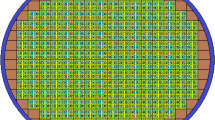Abstract
The prediction of nuclear reactor fuel burn-up rates throughout a reactors lifetime is an important problem in reactor core design. In this study, we present a novel algorithm called BuCal code. This code was used to perform burn-up analysis for a pressurized water reactor fuel with \({\text{UO}}_{2 }\) whose concentration is 19.5% enriched. Simulation results indicate that the total estimate of 235U consumption in 225 days with high neutron fluence is approximately 99.9% of the initial value. The study further showed that the microscopic absorption and fission cross sections decreases with increasing temperature and the concentrations of 235U and 238U decreases as the numbers of days increases while 236U build-up as the number of days increases.










Similar content being viewed by others
References
Pusa ME (2013) Numerical methods for nuclear fuel burn-up calculations. Ph.D. Thesis, VTT Technical Research Institute, Aalto University, Otakaari
Mathew WF, Charles FW, Marco TP, Ian CG (2014) Reactor fuel isotopics and code validation for nuclear applications. Oak Ridge National Laboratory
Fabiano SP, Fernando CS, Aquilino SM (2011) Solution of the isotopic depletion equation using decomposition method and analytical solutions. Cidade Universitaris, Brazil
Lamarsh JR (1966) Theory of nuclear reactor. Addison-Wesley Publishing Company, New York University, New York
Duderstadt JJ, Hamilton LJ (1976) Nuclear reactor analysis. Department of Nuclear Engineering, The University of Michigan
Moler C, Van Loan C (2003) Nineteen dubious ways to compute the exponential of a matrix, twenty-five years later, vol 45. Society for Industrial and Applied Mathematics, Department of Computer Science, Cornell University, New York, pp 801–836 (2003)
Hermann OW, Westfall RM (1998) ORIGEN-S, scale system module to calculate fuel depletion actinide transmutation, fission product build-up, decay and associated radiation source terms. Oak Ridge National Laboratory, Tennessee
Jayeola MA, Fasasi MK, Amosun AA, Salau AO, Ojo BM (2018) Numerical computation of fission product poisoning build-up and burn-up rate in a finite cylindrical nuclear reactor core. Bilge Int J Sci Technol Res 2(1):17–30
Okumura K, Oka Y, Ishiwatari Y (2014) Nuclear reactor calculations. In: Oka Y (ed) Nuclear reactor design. An advanced course in nuclear engineering, vol 2. Springer, Tokyo. https://doi.org/10.1007/978-4-431-54989-0_2
Berthou B, Deguelgre C, Magill J (2003) Transmutation characteristics in thermal and fast neutron spectra: application to Americium. J Nucl Mater 320:156–162
Stacey WM (2007) Nuclear reactor physics. Wiley-VCH verlay GmbH; Co. KGaA, Weinheim
Bosler GE, Philips JR, Wilson B, La Bauve RJ, England TR (1982) Production of actinide isotopes in simulated PWR fuel and other influence on inherent neutron emission. International Atomic Energy Agency, Vienna
Parma EJ (2002) A nuclear reactor burn-up code using MCNP tallies. A report from Sandra National Laboratory, Mexico
Grasso IG, Sumini IM (2010) Neutronics analyses for fast spectrum nuclear system and scenario studies for advanced nuclear fuel cycles. University Degli Studi Di Bologna
Rabba JA, Onimisi MY, Salamu AA, Samson DO (2016) Determination of the consumption rate in the core of the Nigeria Research Reactor-1(NIRR-1) fueled with 19.75% UO2 material. Department of Physics, Federal University Lokoja, Kogi State, Nigeria
Ojo BM, Fasasi MK, Salau AO, Olukotun SF, Jayeola MA (2018) Criticality calculation of a homogenous cylindrical nuclear reactor core using four-group diffusion equations. Turk J Eng 2(3):130–138. https://doi.org/10.31127/tuje.411549
Author information
Authors and Affiliations
Corresponding author
Rights and permissions
About this article
Cite this article
Amosun, A.A., Salau, A.O., Fadodun, O.G. et al. Numerical calculation of fuel burn-up rate in a cylindrical nuclear reactor. J Radioanal Nucl Chem 319, 459–470 (2019). https://doi.org/10.1007/s10967-018-6361-8
Received:
Published:
Issue Date:
DOI: https://doi.org/10.1007/s10967-018-6361-8




